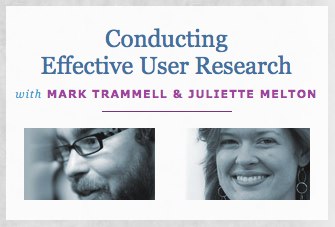As previously noted, I gave a presentation to BayCHI on January 12, 2010. Folks have been asking for the slides — here you go! (photo by Coley Wopperer)
Category Archives: presentations
Next week at BayCHI: “Real World Remote Research”
Next Tuesday, Jan. 12, I’ll be presenting to BayCHI about how to do great user research with remote methods.
The program description:
Remote research can raise the quality and lower the costs of your user research efforts; using a combination of surveys, video, screensharing, and phone, you can connect with a much broader range of users than you could using traditional lab-based usability tests, while using resources more efficiently than you would doing contextual research. In this workshop-style talk, Juliette Melton will cover recruiting sources, technology tools, and caveats you might not have thought of, including managing time zones and participant distraction. We will also address pros and cons of increasingly popular non-scripted research services.
I hope to see you there!
Excited for the DIYSummit (which is *not* a webinar)
Tomorrow, September 17 at 12pm CT Mark Trammell and I will be presenting a talk on “Effective User Research” as part of the DIYsummit. I’m pretty excited. This will be a great group of speakers, and the folks behind the scenes (waving to Christopher and Ari) know their stuff.
The DIYsummit will take place online. This does not, however, make it a “webinar” at least as far as my definition goes. A webinar is a slog through PowerPoint slides, presented online by a lifeless salesperson trying to sell some enterprise software solution. The DIYsummit looks like it will be a well-crafted and really engaging online learning experience.
Anyway, wish us luck and I hope to see you online tomorrow!
Why webinars are generally bad and how they could be better
The typical “webinar” that I have experienced thus far involves an instructor speaking on a conference call while she pages through a series of slides that are viewable using screen sharing software such as WebEx. There could be some great webinars out there, but the ones that I’ve been involved with as a participant could be much better, both from pedagogical and user experience perspectives.
In a classroom, the instructor can look around the room to see if the students look confused or bored. This feedback helps her know if she should go back and explain a difficult point in a different way, or maybe tell a good story to wake the audience up. She can also ask poll the students, through a show of hands or more advanced solution, to discern the level of expertise of the group. She can then adjust her presentation as necessary.
A webinar instructor cannot see her audience. She doesn’t know if people are paying attention or falling asleep. She can’t easily poll her audience about their understanding of the material. She slogs through, slide by slide, with no way to easily adjust her delivery of the content or even know that she should adjust it.
Now let’s think about what a website can do, pedagogically. A user can go through material at his own speed, diving deeper into subject matter that he’s interested in or looking up any words that he hasn’t heard before.
The rigid nature of the webinar environment means that participants can’t adapt the experience to meet their learning needs, like they can on a website, and the instructor can’t adapt her presentation delivery like she can with an in-person lecture.
I posit that the webinar could be a much better learning tool by incorporating some of these aspects of in-person and online learning:
- Have the slide deck available for viewing or downloading at the beginning of the presentation. The participants can then go back and look at previous slides if they missed something, or skip ahead if they want to understand where the discussion is going.
- If the screen sharing tool has a chat function, use it. Ask the participants at the beginning of the session to share their level of expertise with the subject matter. You can make this easier by specifying for example that 1=newbie, 2=somewhat familiar, and 3=very familiar, and have them just type that one number. A quick scan will help clarify what kind of audience you have.
- Decide on a Twitter hashtag for the session, and share it at the beginning. Encourage participants to use the hashtag in their tweets. Monitoring the Twitter backchannel is a good way to know if the participants are bored or confused. (They are unlikely to use the screen sharing chat function to do this.)
- Share a list of URLs with the participants where they can get more information about your subject matter. Advanced members of your audience will benefit from being able to go deeper into the topic while listening to the presentation.
- Encourage the participants to use either the screen sharing chat function or Twitter to ask questions during the presentation.
Let me know if you have other tips! Let’s make webinars a better learning experience.

